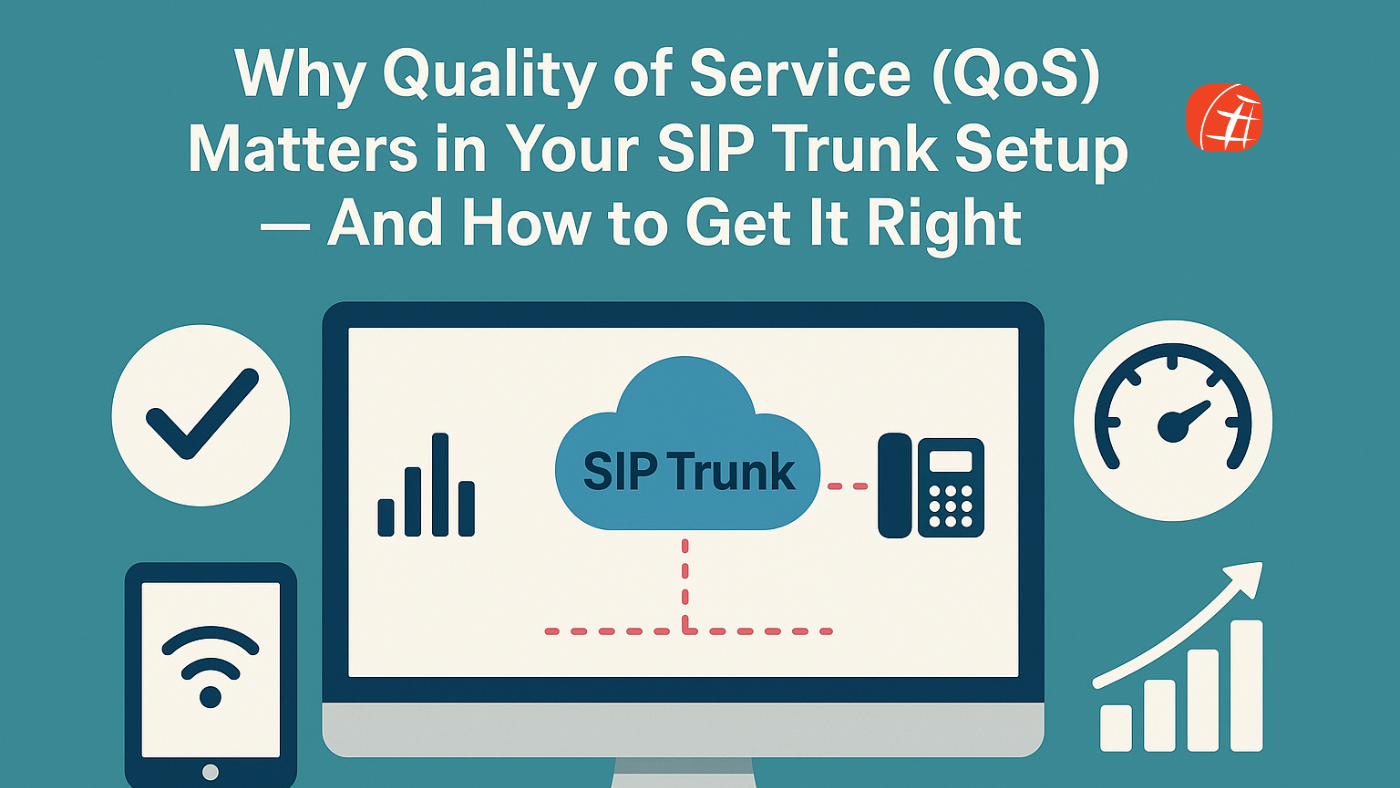When businesses switch to SIP trunking, they often expect reduced costs, easy scalability, and better communication. While all of that is true, one factor determines whether your SIP trunk setup actually delivers on its promise: Quality of Service (QoS).
QoS is the backbone of high-performing VoIP and SIP trunking solutions. Without it, even the most advanced phone system can suffer from call quality issues, dropped calls, jitter, or long delays in conversations. In this blog, we’ll break down why SIP trunk QoS is essential, the common challenges businesses face, and how to get it right for a flawless communication experience.
What Is Quality of Service (QoS)?
In networking, Quality of Service refers to the ability to prioritize and manage data traffic so that critical services (like voice calls) receive the bandwidth and stability they need. Unlike emails or file downloads that can tolerate delays, real-time SIP trunk calls are highly sensitive to latency, jitter, and packet loss.
With QoS in place, your network ensures that voice traffic is prioritized above less urgent data, giving your business communications uninterrupted clarity and reliability.
Why QoS Matters in SIP Trunking
1. Prevents Call Quality Issues
One of the most common concerns in VoIP and SIP trunks is call quality issues—such as echoes, robotic voices, or dropped connections. These often occur when voice packets compete with other types of traffic on the same network. QoS assigns priority to voice packets, ensuring that calls sound clear and professional.
2. Reduces Latency in SIP Trunk Calls
Latency in SIP trunk calls—the delay between when someone speaks and when the other party hears it—can make conversations frustrating. High latency makes collaboration harder, especially in fast-paced business environments. QoS minimizes this delay by controlling how packets travel across your network.
3. Optimizes Bandwidth Usage
Modern offices run dozens of applications simultaneously—video conferencing, file sharing, cloud apps, and more. All of this traffic eats into available bandwidth. With bandwidth optimization through QoS, you don’t need excessive internet capacity. Instead, your existing bandwidth is intelligently allocated so that calls always get the resources they need.
4. Enhances Customer Experience
Imagine a potential customer calling and hearing distorted audio or frequent drops. That first impression can cost you a deal. By prioritizing QoS, businesses using SIP trunks ensure that customer-facing calls are always smooth, leading to higher satisfaction and trust.
5. Protects Business Productivity
Unreliable communication leads to wasted time and lost opportunities. When employees experience poor call quality, meetings take longer, misunderstandings increase, and customer service suffers. QoS ensures that SIP trunking becomes an enabler of productivity, not a barrier.
Common Call Quality Issues Without QoS
Without proper QoS settings, businesses often encounter:
-
Jitter: Uneven delivery of voice packets, causing garbled or choppy sound.
-
Packet Loss: Missing voice data that results in words or entire phrases being cut out.
-
Latency: Noticeable delay between speaking and hearing the other party.
-
Echo: Repetition of sound, which distracts and confuses callers.
These issues don’t just frustrate users—they directly impact customer relationships and business efficiency.
https://www.cebodtelecom.com/improve-voip-call-quality
How QoS Works in SIP Trunking
QoS in SIP trunks works by assigning priority levels to different types of data. Here’s a simplified breakdown:
-
Voice Packets = High Priority: Voice calls are prioritized above everything else.
-
Critical Business Apps = Medium Priority: Applications like CRM or collaboration tools come next.
-
Background Traffic = Low Priority: Downloads, updates, or non-urgent traffic are given the least priority.
This approach guarantees that SIP trunk QoS maintains call stability even during peak usage.
Best Practices to Get SIP Trunk QoS Right
Implementing QoS isn’t complicated, but it does require planning. Here’s how to make it effective for your business:
1. Assess Your Network
Before deploying SIP trunks, conduct a network assessment. Identify current bandwidth usage, potential bottlenecks, and whether your infrastructure can support additional voice traffic.
2. Allocate Sufficient Bandwidth
Each SIP call typically requires 80–100 kbps of bandwidth. Multiply this by the maximum number of simultaneous calls to calculate what you need. Pair this with bandwidth optimization so calls remain smooth even under heavy load.
3. Configure Routers and Firewalls for QoS
Modern routers and firewalls include settings for quality of service in networking. Work with your IT team or SIP provider to configure these settings, ensuring voice traffic always takes precedence.
4. Monitor for Latency, Jitter, and Packet Loss
QoS is not a “set and forget” solution. Continuously monitor for latency in SIP trunk calls, packet loss, and jitter to ensure issues are addressed quickly.
5. Partner With a Reliable SIP Provider
Even the best internal setup won’t help if your SIP trunk provider doesn’t support high-quality connections. At DIDforSale, we prioritize SIP trunk QoS by delivering direct carrier-grade connections, multiple routing options, and 24/7 monitoring to guarantee reliability.
DIDforSale Advantage: Built-In QoS for Superior Call Experience
At DIDforSale, we understand that clear communication is the foundation of business success. That’s why our SIP trunking solutions are designed with QoS in mind. Here’s how we help businesses achieve exceptional call quality:
-
Carrier-Grade Infrastructure: Direct interconnects with top carriers for maximum reliability.
-
Scalable Bandwidth: Adjust resources as your call volume grows without compromising quality.
-
Real-Time Monitoring: Continuous monitoring to detect and fix call quality issues instantly.
-
Expert Support: Our team assists with QoS configuration to ensure smooth deployment.
With DIDforSale, you don’t just get SIP trunks—you get a communication partner committed to crystal-clear, interruption-free calling.
Conclusion
SIP trunk QoS is more than just a technical setting—it’s the difference between smooth, professional conversations and frustrating communication breakdowns. By prioritizing QoS, businesses can eliminate call quality issues, reduce latency in SIP trunk calls, and achieve efficient bandwidth optimization.
When done right, QoS transforms SIP trunking into a reliable, scalable, and customer-friendly communication system. And with a trusted partner like DIDforSale, you can be confident your SIP trunk setup is built for excellence.
Related Blog
Common SIP Trunking Challenges and How to Overcome Them
How to troubleshoot common SIP problems?





